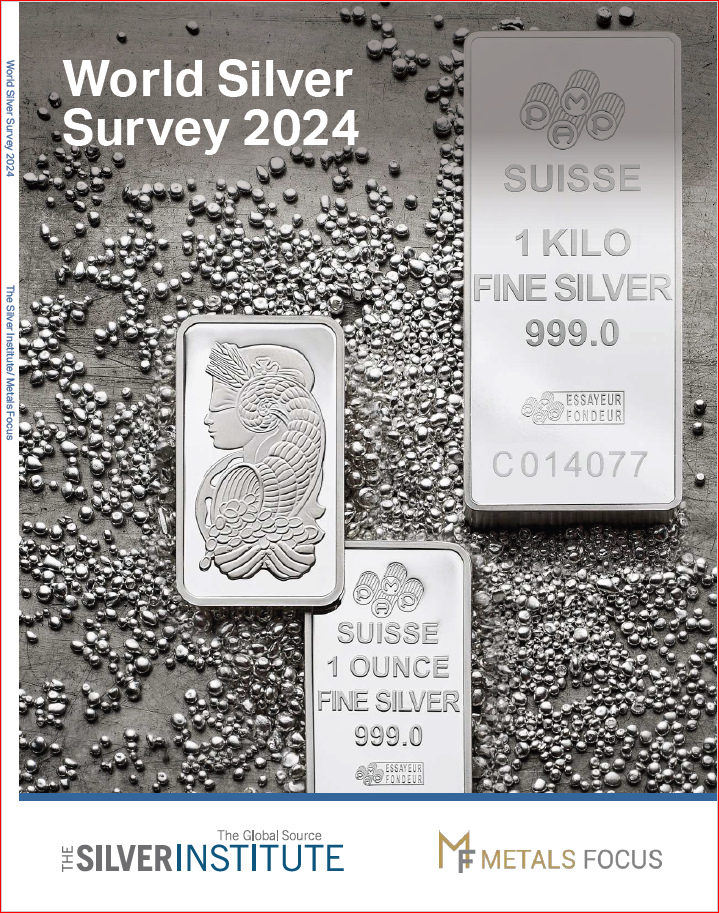The Silver Institute has published the World Silver Survey since 1990. The purpose then, as now, is to provide market participants and observers a comprehensive look at the global silver market during the preceding year, with an in-depth look at the various components of silver demand and the areas that contribute to supplying the market with the white metal. Over the past 34 years, the World Silver Survey has been a trusted source of information about the broader silver market, widely quoted and referenced by industry, governments, media, and others.
From the Introduction:
For yet another year and the third in a row now, silver demand massively
exceeded supply in 2023. While the global market deficit fell by 30% y/y
from last year’s likely all-time-high, at 184.3Moz (5,732t) it was still one of the
largest figures on record. Crucially, last year’s deficit coincided with a year in
which we experienced sharp declines in bar and coin investment, jewelry and
silverware demand that meant global silver offtake fell overall year-on-year.
The silver market’s deficit conditions have so far been resilient to pressures
from the weaker price elastic elements of demand.
Underpinning silver’s fundamentals is robust demand from industrial
applications. These continued to push higher last year, reaching a new alltime
record, fueled by the remarkable rise in solar demand and in spite of
stagnation in some other sectors. Sluggish silver supply, owing to the slight
decline in global mine production, was another factor contributing to silver’s
deficit conditions last year.
Importantly, we remain confident that such deficit conditions will remain in
place for the foreseeable future. As we discuss in detail in Chapter 2, our
projections for 2024 see the gap between supply and demand grow by 17%,
thanks to ongoing growth in industrial demand, a recovery in jewelry and
silverware and still stagnant supply from both mine production and recycling.
With further gains in industrial demand likely in the medium term and no
obvious sources of supply growth, we believe the status quo will continue.
So far, silver’s strong physical market conditions have done little to support
its price. Although the average rose by 7% y/y in 2023, the price moved
sideways in general over the year. It has also been arguably disappointing
that silver has failed to outperform gold during the recent rallies in the latter
metal through to all-time highs. After all silver has often been seen as a high
beta version of gold. Yet as the yellow metal rallied by over 20% from its
October trough through to end-March, the gold:silver ratio in fact inched up
and was trading at a historically high level around 90:1.
In our view, the key challenge silver has been facing are still high aboveground
inventories. As the data in the last focus box of Chapter 3 shows,
stocks held in London and exchange-registered vaults amounted to nearly
15 months of global supply at end-2023 and there are bullion inventories also
held elsewhere. This has prevented a physical squeeze from emerging in the
market, in spite of the robust supply-demand conditions discussed above.
In turn, this has continued to place the fate of the silver price in the hands
of institutional investors. While the macroeconomic backdrop has turned
positive for precious metals, the focus has centered on gold, owing to its
clearer quasi-monetary attributes, wider acceptance as a safe haven and
central banks’ strong interest in the metal. Furthermore, even if silver’s actual
industrial demand is robust, investor enthusiasm in the broader industrial
metals complex has been cooled by a sputtering Chinese economy. Lastly,
rangebound silver prices have encouraged more speculative investors to
seek out buoyant alternatives, such as certain tech stocks and bitcoin.
Still, stocks for the time being may seem plentiful but inventories are by
definition finite. In time, the continued deficits will see them get drawn down
and eventually the market will tighten. Already this is starting to happen in
specific markets to an extent. This is most notable in China where in recent
years we have typically seen massive local oversupply, huge exports and
local silver prices trading at a deep discount to London. Since late 2023, we
have seen discounts ease and most recently turn into small premiums, and
exports come under pressure. While it may not happen immediately, silver
prices will thus sooner or later have their time to shine.






